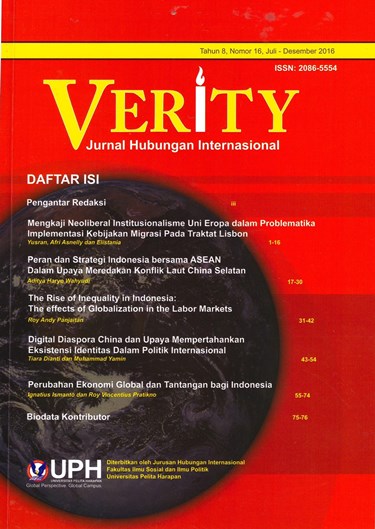Peran dan Strategi Indonesia bersama ASEAN Dalam Upaya Meredakan Konflik Laut China Selatan [The Role and Strategy of Indonesia with ASEAN to Reduce Conflict in the South China Sea]
DOI:
https://doi.org/10.19166/verity.v8i16.723Keywords:
Indonesia, ASEAN, South China Sea, South China Sea Conflict, territorial disputeAbstract
The conflict in the South China Sea which took place from 1992 until July 2016 needs to be immediately resolved. The Government of Indonesia has seen many stakeholders strive to alleviate the conflict in a peaceful manner. ASEAN as a regional forum for countries in the region has recognized that Indonesia would need group support to confront China's increasingly unstoppable influence.
It can be seen that in the South China Sea conflict, Indonesia has played a part in the formation of Declaration of Conduct between ASEAN and China and has also established a trust building workshop with the participants. It is extremely important to note that efforts made by the Government of Indonesia in carrying out its role of leadership is absolutely necessary to building mutual trust among the ASEAN countries. Moreover, together with ASEAN, Indonesia will need to be able to continue working together in the face of pressure and influence coming from China.
References
Ba, A. (2014). Managing the South China Sea disputes: What can ASEAN do? In M. Hiebert, P. Nguyen & G. B. Poling (Eds.), Perspective on the South China Sea: Diplomatic, Legal, and Security Dimensions of the Dispute (pp. 1-12). Washington, DC: CSIS.
CSIS. (2016). Arbitration Timeline. Retrieved 16 June 2016 from http://amti.csis.org/ArbitrationTL
Hunt, L. (2012, July 20). ASEAN Summit fallout continues. The Diplomat. Retrieved 16 June 2016 from http://thediplomat.com/2012/07/asean-summit-fallout-continues-on
Kementerian Luar Negeri RI (2013, February 28). Laut China Selatan. Retrieved 7 June 2016 from http://www.kemlu.go.id/id/kebijakan/isu-khusus/Pages/Laut-China-Selatan.aspx
Kementerian Luar Negeri RI (N.d.). ASEAN Regional Forum (ARF). Retrieved November 16, 2016 from http://kemlu.go.id/id/kebijakan/kerjasama-regional/Pages/ARF.aspx
Kementerian Luar Negeri RI. (2011, November 8). Lokakarya Laut China Selatan ke-21, Surakarta, 9-11 November 2011. Retrieved June 7, 2016 from http://www.kemlu.go.id/id/berita/siaran-pers/Pages/Lokakarya-Laut-China-Selatan-ke-21-Surakarta-9-11-November-2011.aspx
Ministry of Foreign Affairs of The People’s Republic of China (2016). Foreign Ministry Spokesperson Hua Chunying's Regular Press Conference on June 20, 2016. Retrieved June 24, 2016 from http://www.fmprc.gov.cn/mfa_eng/xwfw_665399/s2510_665401/t1373744.shtml
Misalucha, C. G. (2014). Locating Southeast Asia in debates on the South China Sea. In M. Hiebert, P. Nguyen & G. B. Poling (Eds.), Perspective on the South China Sea: Diplomatic, Legal, and Security Dimensions of the Dispute (pp. 104-114). Washington, DC: CSIS.
Morley, J. W. & Nishihara, M. (1997). Vietnam Joins the World. New York: M.E. Sharpe.
Rowan, J. P. (2005). The U.S.-Japan security alliance, ASEAN, and the South China Sea dispute. Asian Survey, 45(3), 414-436. https://doi.org/10.1525/as.2005.45.3.414
Scott, D. (2012). Conflict irresolution in the South China Sea. Asian Survey, 52(6), 1019-1042. https://doi.org/10.1525/as.2012.52.6.1019
Sudira, I. N. (2014). Konflik Laut China Selatan dan Politik Luar Negeri Indonesia ke Amerika dan Eropa. Jurnal Ilmiah Hubungan Internasional, 10(2), 143-161.
U.S. Energy Information Administration. (2013, February 7). South China Sea. Retrieved June 8, 2016 from https://www.eia.gov/beta/international/regions-topics.cfm?RegionTopicID=SCS
Wortzel, L. M. & Higham, R. D.S. (1999). Dictionary of Contemporary Chinese Military History. Santa Barbara, CA: ABC-CLIO.
Yosephine, L. (2016, June 17). Indonesia stresses ASEAN common stance on South China Sea consistent. The Jakarta Post. Retrieved June 18, 2016 from http://www.thejakartapost.com/seasia/2016/06/17/indonesia-stresses-asean-common-stance-on-south-china-sea-consistent.html
Downloads
Published
Issue
Section
License
Authors who publish with this journal agree to the following terms:
1) Authors retain copyright and grant the journal right of first publication with the work simultaneously licensed under a Creative Commons Attribution License (CC-BY-SA 4.0) that allows others to share the work with an acknowledgement of the work's authorship and initial publication in this journal.
2) Authors are able to enter into separate, additional contractual arrangements for the non-exclusive distribution of the journal's published version of the work (e.g., post it to an institutional repository or publish it in a book), with an acknowledgement of its initial publication in this journal.
3) Authors are permitted and encouraged to post their work online (e.g., in institutional repositories or on their website). The final published PDF should be used and bibliographic details that credit the publication in this journal should be included.


